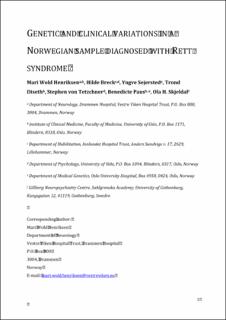| dc.contributor.author | Henriksen, Mari Wold | |
| dc.contributor.author | Breck, Hilde | |
| dc.contributor.author | Sejersted, Yngve | |
| dc.contributor.author | Diseth, Trond H | |
| dc.contributor.author | von Tetzchner, Stephen | |
| dc.contributor.author | Paus, Benedicte | |
| dc.contributor.author | Skjeldal, Ola Hunsbeth | |
| dc.date.accessioned | 2023-04-12T12:16:19Z | |
| dc.date.available | 2023-04-12T12:16:19Z | |
| dc.date.created | 2020-06-11T22:46:45Z | |
| dc.date.issued | 2020 | |
| dc.identifier.citation | Brain & development (Tokyo. 1979). 2020, 42 (7), 484-495. | en_US |
| dc.identifier.issn | 0387-7604 | |
| dc.identifier.uri | https://hdl.handle.net/11250/3062676 | |
| dc.description.abstract | Background and purpose: Rett syndrome (RTT) is a neurodevelopmental disorder mainly caused by mutations in MECP2. The diagnostic criteria of RTT are clinical; mutations in MECP2 are neither diagnostic nor necessary, and a mutation in another gene does not exclude RTT. We attempted to correlate genotype and phenotype to see if there are significant clinical associations. Methods: All available females diagnosed with RTT in Norway were invited to the study. Parents were interviewed, the girl or woman with RTT examined and medical records reviewed. All diagnoses were revisited according to the current diagnostic criteria and exome-based sequencing analyses were performed in individuals without an identified causative mutation. Participants were categorized according to genotypes and RTT diagnosis. Individuals with RTT with and without mutations in MECP2 were compared. Results: Ninety-one individuals were included. A presumed causative mutation was identified in 86 individuals, of these, mutations in MECP2 in 77 individuals and mutations in SMC1A, SYNGAP1, SCN1A, CDKL5, FOXG1 or chromosome 13q in nine. Seventy-two individuals fulfilled the diagnostic criteria for classic and 12 for atypical RTT. Significant differences in early development, loss of hand use and language, intense eye gaze and the presence of early onset epilepsy were revealed in individuals with RTT according to their MECP2 genotypic status. Conclusion: Using the current diagnostic criteria, genetic and clinical variation in RTT is considerable. Significant differences between individuals with RTT with and without MECP2 mutations indicate that MECP2 is a major determinant for the clinical phenotype in individuals with RTT. Keywords: Clinical phenotype; Epilepsy; Exome sequencing; Genetic variation; MECP2; Rett syndrome. | en_US |
| dc.language.iso | eng | en_US |
| dc.rights | Attribution-NonCommercial-NoDerivatives 4.0 Internasjonal | * |
| dc.rights.uri | http://creativecommons.org/licenses/by-nc-nd/4.0/deed.no | * |
| dc.title | Genetic and clinical variations in a Norwegian sample diagnosed with Rett syndrome | en_US |
| dc.type | Peer reviewed | en_US |
| dc.type | Journal article | en_US |
| dc.description.version | acceptedVersion | en_US |
| dc.source.pagenumber | 484-495 | en_US |
| dc.source.volume | 42 | en_US |
| dc.source.journal | Brain & development (Tokyo. 1979) | en_US |
| dc.source.issue | 7 | en_US |
| dc.identifier.doi | 10.1016/j.braindev.2020.03.008 | |
| dc.identifier.cristin | 1815132 | |
| cristin.ispublished | true | |
| cristin.fulltext | postprint | |
| cristin.qualitycode | 1 | |

